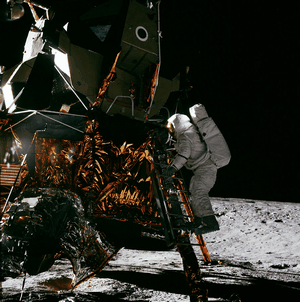While the first mission to the moon gets all the attention (and the near disaster of Apollo 13 was immortalize as a testament to succeed against all odds in the movie Apollo 13) it is important to note that subsequent space missions made great scientific breakthroughs as well. As the technology used to send men into space continued to mature, other space missions were planned and executed, and those missions helped us gain a new understanding of the universe and our place in the cosmos.
One of the most fascinating, yet forgotten, missions of the original NASA Apollo missions was launched on November 14, 1969 and landed on the moon some 10 days later on November 24. The Apollo 12 mission to the moon explored the so-called Ocean of Storms on the moon, which at the time was one of the most mysterious parts of the lunar landscape. The mission was led by Charles ‘Pete’ Conrad, a notable figure in the world of manned spaceflight. Also on board were
Alan L. Bean and Richard F. Gordon, Jr.
Conrad was one of the few to be launch into space by the massive Saturn V rocket. To date, the Saturn V rocket is the only rocket to launch humans beyond earth’s low orbit. Apollo 12 separated from the Saturn 5 rocket and Conrad piloted the Apollo 12 spacecraft to the moon and orchestrated a pinpoint landing of Apollo 12’s lunar module on the moon’s surface. This feat was considered previously as nearly impossible and proved that such a precise landing was indeed possible. This was an important goal in and of itself, since the earlier Apollo 11 mission had landed some four miles from its intended target. To make this accomplishment even more impressive, Conrad landed the lunar module in the middle of a blinding dust storm and still put the ship down in nearly the exact location NASA had mapped out.
After that pinpoint landing Conrad would become only the third man to set foot on the lunar surface. The primary goal of the Apollo 12 mission was to set up an self-sustaining scientific station that would record valuable scientific data about the lunar surface and the surrounding landscape.  The scientific instruments deployed during the mission included a seismometer to measure geologic activity, a magnetometer to search for a lunar magnetic field and a sensor to explore the atmosphere. The Apollo 12 mission also visited the site of the Surveyor III spacecraft in order to collect parts of the probe so that they could be studied. The data collected, to date, is considered invaluable to astronomers looking to understand the makeup, environmental conditions and history of the moon itself.
The scientific instruments deployed during the mission included a seismometer to measure geologic activity, a magnetometer to search for a lunar magnetic field and a sensor to explore the atmosphere. The Apollo 12 mission also visited the site of the Surveyor III spacecraft in order to collect parts of the probe so that they could be studied. The data collected, to date, is considered invaluable to astronomers looking to understand the makeup, environmental conditions and history of the moon itself.
Another important part of the Apollo 12 mission was the recovery of gear from the spacecraft that had landed on the moon during the earlier Apollo 11 mission. During their next excursion Conrad and his team removed the camera from the surveyor, as well as pieces of electrical cable and structural tubing. These pieces would be studied by NASA in an attempt to make improvements for future manned space missions.
The Apollo 12’s crew also collected rock samples from the mysterious ‘Ocean of Storms’ terrain which were brought back to earth so scientist could get a better understanding of the region of the moon (some of these rock samples are on display at the Seattle Museum of Flight). In 1969, there were still many unanswered questions about the moon. Was it once part of earth? Had there ever been volcanic activity on the moon? Was there water on the moon, or had there been water present in the past?
The many accomplishments of the Apollo 12 mission may not be known to many, yet the science and answers collected by this mission about space, the moon, the universe continue to enlighten us and advance human knowledge. While many people are more familiar with other Apollo missions, it is important to take a fresh look at the accomplishments and scientific breakthroughs that the Apollo 12 mission made possible. Without the brave astronauts who set out for the moon on that mission we would not know nearly as much about the unique nature of the lunar landscape.
Next time you look at your mobile phone, consider that the technology in that phone in your hand is a 1000 times more powerful than the technology used to take the first men to the moon. And, the original technology developed by NASA to accomplish the moon missions became the seeds of knowledge that lead to the creation of your mobile phone (such as the development of integrated circuits making your cell phone possible).

